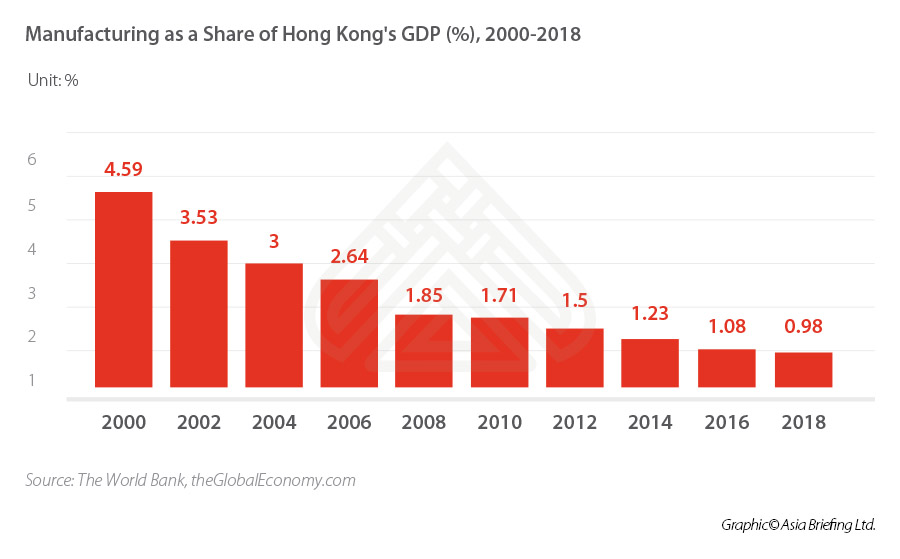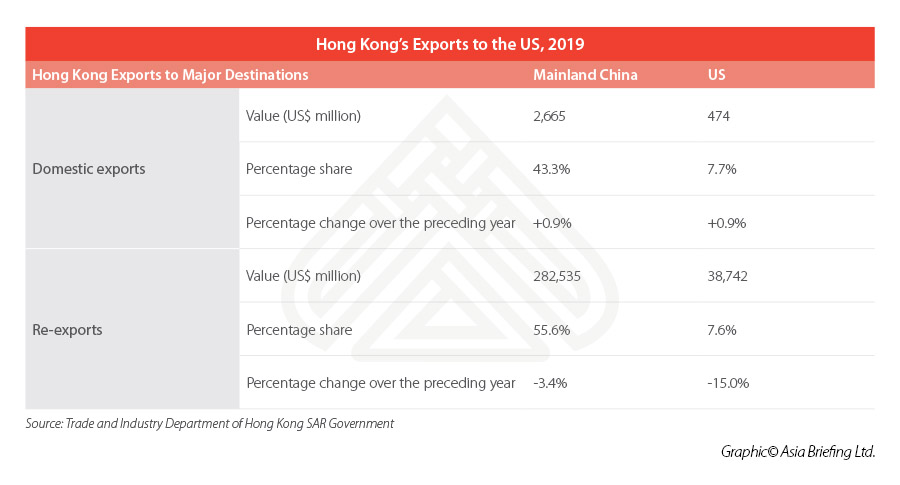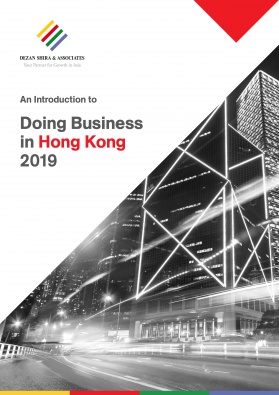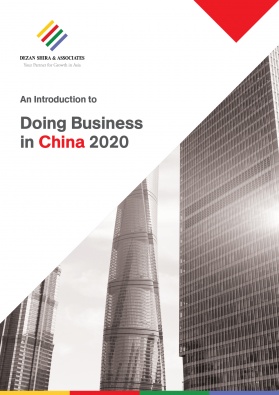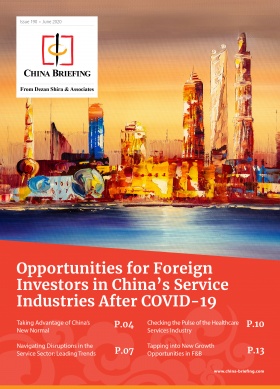Hong Kong’s US-Bound Exports to be Labeled ‘Made in China’: What Does it Mean?
- The US government released a notice stating that Hong Kong goods for export to the US must be relabeled ‘Made in China’ instead of ‘Made in Hong Kong’. Improperly labeled cargo may face a punitive duty of 10 percent.
- The labeling requirement – which was supposed to come into effect September 25, 2020 has now been postponed by 45 days to November 9, 2020.
- According to clarification from the US government, the labeling change does not automatically change a product’s tariff designation. Hong Kong goods could still use “HK” as a country of origin.
- Therefore, goods made in Hong Kong may not be subject to the trade war tariffs levied on Mainland Chinese products, for now. Even so, the number of Hong Kong goods affected is very small.
- The labeling rule won’t have much financial impact but will be an irritant in an already strained US-China relationship.
Goods produced in Hong Kong and exported to the US must be “marked to indicate that their origin is China”, according to the notice put out by US Customs and Border Protection (CBP) on August 11, 2020.
This ‘Made in China’ labeling requirement on Hong Kong products was originally to take effect on September 25. To give Hong Kong exporters more breathing room to switch the labels, the US CBP has extended the enforcement date by 45 days, to November 9. At that time, goods that fail to comply with this rule will face a punitive a duty of 10 percent ad valorem.
Since the notice was released, markets initially assumed that this implied that Hong Kong exports to the US may soon face the additional tariffs levied by the US on Chinese products amid the trade war between the two countries.
However, the CBP later issued a clarification, saying that the labeling rule won’t affect country of origin determinations for the purpose of assessing duties under the Harmonized Tariff Schedule of the United States (HTSUS). Hong Kong exports can continue to report “HK” as the country of origin.
This article examines which products will need to get labeled ‘Made in China’ and what the loss of ‘Made in Hong Kong’ means for businesses.
Impact of the loss of ‘Made in Hong Kong’ label
How many Hong Kong exports will be relabeled ‘Made in China’?
Unlike the 1950s to 1970s, when Hong Kong was an important manufacturing stronghold for light industrial products like electronics, watches, and toys and the “Made in Hong Kong” label enjoyed international reputation – Hong Kong’s economy is currently dominated by services. The services industry accounts for about 93 percent of GDP while the share of manufacturing has shrunk to just around one percent in 2018-2019.
Rather than being a direct trading center, Hong Kong mainly serves as a re-export hub for merchandise trade between the Chinese mainland and the rest of the world – Hong Kong’s home-made exports was only 1.2 percent of its total outbound shipments (including re-exports) in 2019.
Among the home-made exports, in 2019, 43.3 percent of Hong Kong goods were shipped to the Chinese mainland and 7.7 percent to the US – these countries are the two largest export markets for Hong Kong.
The 7.7 percent exports to the US (around US$470 million worth of Hong Kong goods exports) is less than 0.1 percent of the city’s total exports (including re-exports) and less than two percent of local manufacturing output.
As the data shows, the removal of the ‘Made in Hong Kong’ label could in reality affect only a very small percentage of Hong Kong’s domestic goods.
What Hong Kong export goods will be labeled ‘Made in China’?
According to the South China Morning Post, during the first half of 2020, 48.5 percent of Hong Kong’s home-made exports to the US in value terms were jewelry items. The second most valuable sector was edible products, accounting for 10.7 percent of domestic outbound shipments. Besides these, Hong Kong also exports electrical machinery, telecommunications, sound recording and reproducing apparatus, office machines, and automatic data processing units to the US. These products may need to be labeled ‘Made in China’ when they are sold to American customers.
Will there be changes in the US tariff treatment on Hong Kong goods?
The CBP clarification means that Hong Kong products will not be treated as Chinese products and be subject to the additional US tariffs of 7.5 to 25 percent.
So, there isn’t a direct financial impact apparent at the moment; however, it is reported that Hong Kong firms are concerned that the labeling rule will likely harm their branding, especially for companies in the technology, luxury goods, or cultural products categories.
Other preferential tariff treatment granted by the US to Hong Kong also still faces the possibility of getting revoked. For example, on August 19, the US government announced it would suspend or terminate three bilateral agreements with Hong Kong, including one reciprocal tax agreement that benefits Hong Kong-registered shipping firms.
Hong Kong’s position amid a fraught US-China relationship
Hong Kong has been caught in the deteriorating relationship between the US and China since 2019. The geopolitical tensions and socioeconomic uncertainties have taken a toll on the city’s economy. In 2019, Hong Kong’s exports to most major destinations fell in value from a year earlier, with exports to the US declining the most, by 14.8 percent, due to the US-China trade war.
In 2020, the COVID-19 pandemic coupled with US-China trade tensions resulted in Hong Kong’s exports to the US further decreasing, by 22.3 percent, from January to May, when compared to the same period last year.
In the second quarter of 2020, Hong Kong’s economy shrank by a ‘unprecedented’ nine percent from a year earlier, which was the fourth consecutive quarter of contraction for its economy.
This July, after Beijing imposed a national security law on Hong Kong, the US president Donald Trump singed an Executive Order on Hong Kong Normalization to unilaterally end Hong Kong’s special trading relationship with the US. That meant Hong Kong-origin products could no longer enjoy lower tariff rates when exporting to the US; the former British colony’s special status as a separate customs jurisdiction as well as a separate member of the World Trade Organization (WTO) used to be recognized by the US under the US-Hong Kong Policy Act of 1992 and why it previously enjoyed lower tariffs.
In addition, the city has also got caught in the US-China tech war with Trump’s order revoking license exemptions on US exports of sensitive technology to Hong Kong in July. The type of technology exports affected include computer chips and dual-use technology – technology that has both civilian and military applications, such as satellites and telescopic lenses used in firearms.
This month, the US placed sanctions on 11 Chinese officials, including Hong Kong’s Chief Executive Carrie Lam, which brought uncertainty to Hong Kong’s financial sector when doing business with the sanctioned officials. In retaliation, China announced sanction against 11 Americans, including key lawmakers.
The relationship between the US and China is still worsening. The Trump administration’s foreign policy hawks have attached urgency to pushing back on all fronts against what they view is an increasingly assertive China. The timing is also important; Trump is in his last weeks of campaigning for re-election. As the US confronts multiple domestic socioeconomic challenges, worsened by its handling of the COVID-19 crisis, foreign policy issues, including trade and technology, have become an arena of political contestation. Beijing, while unwilling to confront the US head-on, is also reluctant to compromise.
In recent weeks, the US has announced imminent bans on Chinese apps, including TikTok and WeChat, sent a cabinet member to Taiwan, and unleashed new curbs on Huawei’s access to US technology besides dissuading European markets from opening to Huawei.
Hong Kong’s position will likely stay precarious in the short-term, not least because of political developments, but also because it functions as China’s financial portal to the world. Unfortunately, the ‘cold war’ tensions between China and the US may last longer than many people think.
(This article was originally published on August 18, 2020. It was last updated August 25, 2020.)
About Us
China Briefing is written and produced by Dezan Shira & Associates. The practice assists foreign investors into China and has done so since 1992 through offices in Beijing, Tianjin, Dalian, Qingdao, Shanghai, Hangzhou, Ningbo, Suzhou, Guangzhou, Dongguan, Zhongshan, Shenzhen, and Hong Kong. Please contact the firm for assistance in China at china@dezshira.com.
We also maintain offices assisting foreign investors in Vietnam, Indonesia, Singapore, The Philippines, Malaysia, Thailand, United States, and Italy, in addition to our practices in India and Russia and our trade research facilities along the Belt & Road Initiative.
- Previous Article The US-China Trade War: A Timeline
- Next Article Foreigners’ Special Visa Application and Entry into China: 3 Case Studies

